Advertisements
Online Mock Tests
Chapters
2: Acids, Bases and Salts
3: Metals and Non-metals
4: Carbon and its Compounds
5: Periodic Classification of Elements
6: Life Processes
7: Control and Coordination
8: How do Organisms Reproduce?
9: Heredity and Evolution
▶ 10: Light – Reflection and Refraction
11: The Human Eye and the Colourful World
12: Electricity
13: Magnetic Effects of Electric Current
14: Sources of Energy
15: Our Environment
16: Management of Natural Resources
![NCERT Exemplar solutions for Science [English] Class 10 chapter 10 - Light – Reflection and Refraction NCERT Exemplar solutions for Science [English] Class 10 chapter 10 - Light – Reflection and Refraction - Shaalaa.com](/images/science-english-class-10_6:5f2b1b2038084cf381bfa42c826a928c.jpg)
Advertisements
Solutions for Chapter 10: Light – Reflection and Refraction
Below listed, you can find solutions for Chapter 10 of CBSE NCERT Exemplar for Science [English] Class 10.
NCERT Exemplar solutions for Science [English] Class 10 10 Light – Reflection and Refraction Multiple Choice Questions [Pages 79 - 83]
Which of the following can make a parallel beam of light when light from a point source is incident on it?
Concave mirror as well as convex lens
Convex mirror as well as concave lens
Two plane mirrors placed at 90° to each other
Concave mirror as well as concave lens
A 10 mm long awl pin is placed vertically in front of a concave mirror. A 5 mm long image of the awl pin is formed at 30 cm in front of the mirror. The focal length of this mirror is
–30 cm
–20 cm
–40 cm
–60 cm
Under which of the following conditions a concave mirror can form an image larger than the actual object?
When the object is kept at a distance equal to its radius of curvature
When object is kept at a distance less than its focal length
When object is placed between the focus and centre of curvature
When object is kept at a distance greater than its radius of curvature
Figure shows a ray of light as it travels from medium A to medium B. Refractive index of the medium B relative to medium A is
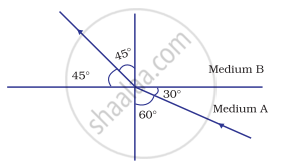
`sqrt3//sqrt2`
`sqrt2//sqrt3`
`1//sqrt2`
`sqrt2`
A light ray enters from medium A to medium B as shown in Figure 10.2. The refractive index of medium B relative to A will be
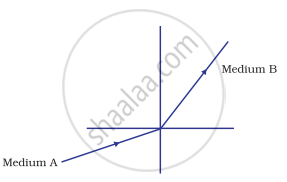
greater than unity
less than unity
equal to unity
zero
Beams of light are incident through the holes A and B and emerge out of box through the holes C and D respectively as shown in the Figure Which of the following could be inside the box?
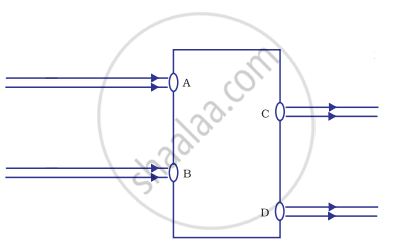
A rectangular glass slab
A convex lens
A concave lens
A prism
A beam of light is incident through the holes on side A and emerges out of the holes on the other face of the box as shown in the Figure. Which of the following could be inside the box?
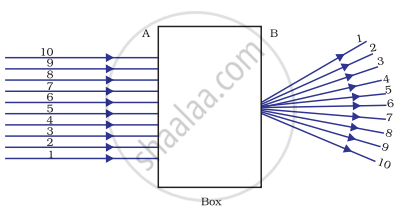
Concave lens
Rectangular glass slab
Prism
Convex lens
Which of the following statements is true?
A convex lens has 4 dioptre power having a focal length 0.25 m
A convex lens has –4 dioptre power having a focal length 0.25 m
A concave lens has 4 dioptre power having a focal length 0.25 m
A concave lens has –4 dioptre power having a focal length 0.25 m
Magnification produced by a rear view mirror fitted in vehicles
is less than one
is more than one
is equal to one
can be more than or less than one depending upon the position of the object in front of it
Rays from Sun converge at a point 15 cm in front of a concave mirror. Where should an object be placed so that size of its image is equal to the size of the object?
15 cm in front of the mirror
30 cm in front of the mirror
between 15 cm and 30 cm in front of the mirror
more than 30 cm in front of the mirror
A full length image of a distant tall building can definitely be seen by using
a concave mirror
a convex mirror
a plane mirror
both concave as well as plane mirror
In torches, search lights and headlights of vehicles the bulb is placed ______.
between the pole and the focus of the reflector
very near to the focus of the reflector
between the focus and centre of curvature of the reflector
at the centre of curvature of the reflector
The laws of reflection hold good for
plane mirror only
concave mirror only
convex mirror only
all mirrors irrespective of their shape
The path of a ray of light coming from air passing through a rectangular glass slab traced by four students are shown as A, B, C and D in Figure Which one of them is correct?
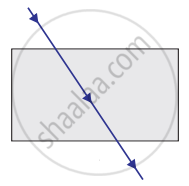 |
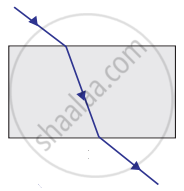 |
 |
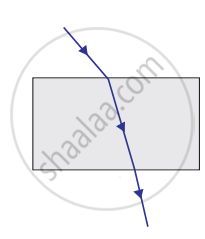 |
| A | B | C | D |
A
B
C
D
You are given water, mustard oil, glycerine and kerosene. In which of these media a ray of light incident obliquely at same angle would bend the most?
Kerosene
Water
Mustard oil
Glycerine
Which of the following ray diagrams is correct for the ray of light incident on a concave mirror as shown in Figure?

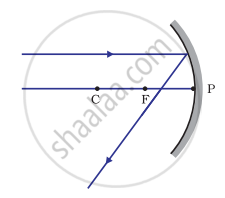 |
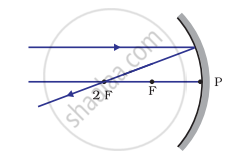 |
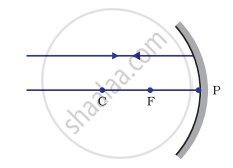 |
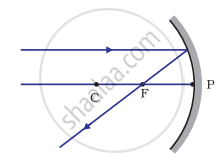 |
| Fig. A | Fig. B | Fig. C | Fig. D |
Fig. A
Fig. B
Fig. C
Fig. D
Which of the following ray diagrams is correct for the ray of light incident on a lens shown in Figure?
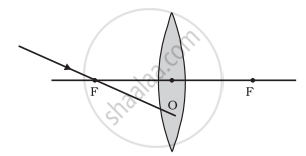
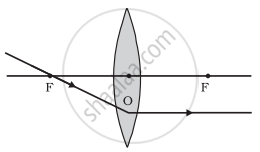 |
 |
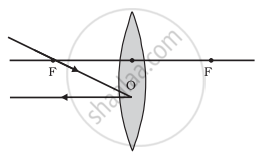 |
 |
| Fig. A | Fig. B | Fig. C | Fig. D |
Fig. A
Fig. B
Fig. C
Fig. D
A child is standing in front of a magic mirror. She finds the image of her head bigger, the middle portion of her body of the same size and that of the legs smaller. The following is the order of combinations for the magic mirror from the top.
Plane, convex and concave
Convex, concave and plane
Concave, plane and convex
Convex, plane and concave
In which of the following, the image of an object placed at infinity will be highly diminished and point sized?
Concave mirror only
Convex mirror only
Convex lens only
Concave mirror, convex mirror, concave lens and convex lens
NCERT Exemplar solutions for Science [English] Class 10 10 Light – Reflection and Refraction Short Answer Questions [Pages 83 - 84]
Identify the device used as a spherical mirror or lens in following case, when the image formed is virtual and erect in case.
Object is placed between device and its focus, image formed is enlarged and behind it.
Identify the device used as a spherical mirror or lens in following case, when the image formed is virtual and erect in case.
Object is placed between the focus and device, image formed is enlarged and on the same side as that of the object.
Identify the device used as a spherical mirror or lens in following case, when the image formed is virtual and erect in case.
Object is placed between infinity and device, image formed is diminished and between focus and optical centre on the same side as that of the object.
Identify the device used as a spherical mirror or lens in following case, when the image formed is virtual and erect in case.
Object is placed between infinity and device, image formed is diminished and between pole and focus, behind it.
Why does a light ray incident on a rectangular glass slab immersed in any medium emerges parallel to itself? Explain using a diagram.
A pencil when dipped in water in a glass tumbler appears to be bent at the interface of air and water. Will the pencil appear to be bent to the same extent, if instead of water we use liquids like, kerosene or turpentine. Support your answer with reason.
How is the refractive index of a medium related to the speed of light? Obtain an expression for refractive index of a medium with respect to another in terms of speed of light in these two media?
Refractive index of diamond with respect to glass is 1.6 and absolute refractive index of glass is 1.5. Find out the absolute refractive index of diamond.
A convex lens of focal length 20 cm can produce a magnified virtual as well as real image. Is this a correct statement? If yes, where shall the object be placed in each case for obtaining these images?
Sudha finds out that the sharp image of the window pane of her science laboratory is formed at a distance of 15 cm from the lens. She now tries to focus the building visible to her outside the window instead of the window pane without disturbing the lens. In which direction will she move the screen to obtain a sharp image of the building? What is the approximate focal length of this lens?
How are power and focal length of a lens related? You are provided with two lenses of focal length 20 cm and 40 cm respectively. Which lens will you use to obtain more convergent light?
Under what condition in an arrangement of two plane mirrors, incident ray and reflected ray will always be parallel to each other, whatever may be angle of incidence. Show the same with the help of diagram.
Draw a ray diagram showing the path of rays of light when it enters with oblique incidence
- from air into water;
- from water into air.
NCERT Exemplar solutions for Science [English] Class 10 10 Light – Reflection and Refraction Long Answer Questions [Pages 84 - 85]
Draw ray diagrams showing the image formation by a concave mirror when an object is placed
- between pole and focus of the mirror
- between focus and centre of curvature of the mirror
- at centre of curvature of the mirror
- a little beyond centre of curvature of the mirror
- at infinity
Draw ray diagrams showing the image formation by a convex lens when an object is placed
- between optical centre and focus of the lens
- between focus and twice the focal length of the lens
- at twice the focal length of the lens
- at infinity
- at the focus of the lens
Write laws of refraction. Explain the same with the help of ray diagram, when a ray of light passes through a rectangular glass slab.
Draw ray diagrams showing the image formation by a concave lens when an object is placed
- at the focus of the lens
- between focus and twice the focal length of the lens
- beyond twice the focal length of the lens
Draw ray diagrams showing the image formation by a convex mirror when an object is placed
- at infinity
- at finite distance from the mirror
The image of a candle flame formed by a lens is obtained on a screen placed on the other side of the lens. If the image is three times the size of the flame and the distance between lens and image is 80 cm, at what distance should the candle be placed from the lens? What is the nature of the image at a distance of 80 cm and the lens?
Size of image of an object by a mirror having a focal length of 20 cm is observed to be reduced to 1/3rd of its size. At what distance the object has been placed from the mirror? What is the nature of the image and the mirror?
Define power of a lens. What is its unit? One student uses a lens of focal length 50 cm and another of –50 cm. What is the nature of the lens and its power used by each of them?
A student focussed the image of a candle flame on a white screen using a convex lens. He noted down the position of the candle screen and the lens as under
Position of candle = 12.0 cm
Position of convex lens = 50.0 cm
Position of the screen = 88.0 cm
- What is the focal length of the convex lens?
- Where will the image be formed if he shifts the candle towards the lens at a position of 31.0 cm?
- What will be the nature of the image formed if he further shifts the candle towards the lens?
- Draw a ray diagram to show the formation of the image in case (iii) as said above.
Solutions for 10: Light – Reflection and Refraction
![NCERT Exemplar solutions for Science [English] Class 10 chapter 10 - Light – Reflection and Refraction NCERT Exemplar solutions for Science [English] Class 10 chapter 10 - Light – Reflection and Refraction - Shaalaa.com](/images/science-english-class-10_6:5f2b1b2038084cf381bfa42c826a928c.jpg)
NCERT Exemplar solutions for Science [English] Class 10 chapter 10 - Light – Reflection and Refraction
Shaalaa.com has the CBSE Mathematics Science [English] Class 10 CBSE solutions in a manner that help students grasp basic concepts better and faster. The detailed, step-by-step solutions will help you understand the concepts better and clarify any confusion. NCERT Exemplar solutions for Mathematics Science [English] Class 10 CBSE 10 (Light – Reflection and Refraction) include all questions with answers and detailed explanations. This will clear students' doubts about questions and improve their application skills while preparing for board exams.
Further, we at Shaalaa.com provide such solutions so students can prepare for written exams. NCERT Exemplar textbook solutions can be a core help for self-study and provide excellent self-help guidance for students.
Concepts covered in Science [English] Class 10 chapter 10 Light – Reflection and Refraction are Spherical Mirrors, Concave Mirror, Convex Mirror, Concave Lens, Introduction to Refraction of Light, Image Formation by Convex Mirror, Mirror Equation/Formula, Sign Convention, Images Formed by Spherical Mirrors, Image Formation by Concave Mirror, Reflection of Light, Law of Reflection of Light, Linear Magnification (M) Due to Spherical Mirrors, Magnification Due to Spherical Lenses, Power of a Lens, Mirrors, Plane Mirror, Rules for the Construction of Image Formed by a Spherical Mirror, Refraction of Light Through a Rectangular Glass Slab, Refractive Index, Spherical Lens, Images Formed by Sperical Lenses, Guideline for Image Formation Due to Refraction Through a Convex and Concave Lens, Images Formed by Concave Lenses, Convex Lens, Images Formed by Convex Lenses, Sign Convention, Lens Formula.
Using NCERT Exemplar Science [English] Class 10 solutions Light – Reflection and Refraction exercise by students is an easy way to prepare for the exams, as they involve solutions arranged chapter-wise and also page-wise. The questions involved in NCERT Exemplar Solutions are essential questions that can be asked in the final exam. Maximum CBSE Science [English] Class 10 students prefer NCERT Exemplar Textbook Solutions to score more in exams.
Get the free view of Chapter 10, Light – Reflection and Refraction Science [English] Class 10 additional questions for Mathematics Science [English] Class 10 CBSE, and you can use Shaalaa.com to keep it handy for your exam preparation.
